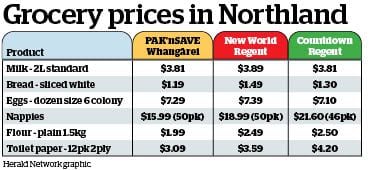Louise Baxter talks about the increase in grocery costs. Photo / Tania Whyte
“Astronomical” is how Whangārei local, Louise Baxter, describes current grocery prices.
Her thoughts are reflected in new Stats NZ figures, released on April 17, which showed food prices were 12.1 per cent higher in March
2023 than in March 2022.
Grocery food items – such as barn or cage-raised eggs – were among the largest contributors to the rise, increasing 14 per cent over the last year. Another big contributor to the annual movement was fruit and vegetables, which have risen by 22 per cent.
The Whangārei locals the Advocate spoke to said they too were noticing the cost of fresh fruit and vegetables.
Baxter said although she has just enough, she could see others were “absolutely struggling.”
This was reiterated by Liz Cassidy-Nelson, chief executive of 155 Whare Āwhina, who said a growing number of people “are really feeling the cost-of-living pressures.
“I know the premise behind a lot of these stories is food, but actually it is the cost of housing that has created the largest, most significant factor for families in terms of cost.
“They must pay their rent. Or they must pay their mortgage. Which then, in turn, means they won’t have enough money to pay for food.
Advertisement
“Food always comes last.”
Because of the increased cost of food, particularly healthy foods, Cassidy-Nelson says, this is where families compromise.
“The stories I have been getting through our social supermarket [155 Whare Kai] is they just bypass the fruit and vege section these days because it is just too expensive,” said Cassidy-Nelson.
/cloudfront-ap-southeast-2.images.arcpublishing.com/nzme/RTOTGDKTVFFUROO4N365ZDZDU4.jpg)
Previous analysis by economic consultancy firm, Infometrics, showed supplier costs represent two-thirds of the on-shelf supermarket prices.
“Supplier cost increases continue to be broad-based across all departments in March, with produce costs from suppliers to Foodstuffs still up more than 20 per cent from a year earlier,” said Infometrics chief executive and principal economist Brad Olsen.
“Even with a 21 per cent per annum increase in produce costs, this figure underestimates the full increase in produce costs, with a number of fresh produce cost increases being outside the parameters of the index [Grocery Supplier Cost Index] – an unusual situation brought about by the cyclone.”
Every month, the Infometrics-Foodstuffs New Zealand Grocery Supplier Cost Index (GSCI) measures the change in the cost of grocery goods charged by suppliers to the Foodstuffs North Island and South Island cooperatives – such as Pak’nSave and New World supermarkets.
“Additional analysis this month shows large increases in apples, pears, potatoes, kiwifruit, and kumara in the wake of Cyclone Gabrielle. Some of these increases are not fully captured in the GSCI due to the way Infometrics excludes cost changes over a certain magnitude for data quality purposes,” explains Olsen.
Advertisement
Whangārei local, Baxter, believes supermarkets should help with the rising grocery costs.
The Commerce Commission estimated Foodstuffs and Countdown were making $430 million a year in excess profits, according to its final report in March 2022 into the grocery industry.
However, the duopoly strongly disputes this figure.
Foodstuffs North Island managing director, Chris Quin, previously told Morning Report the company had held price increases to customers below the food price index and supplier cost increases in March.
“We managed to work hard on seeing what we could do around specials and reducing our costs and getting retail prices not to flow all of that through.”
When the Advocate investigated the cost of essential grocery items last Wednesday, Foodstuffs’ Whangārei Pak’nSave was consistently the cheapest option – with the exception of eggs.
It was more even between Regent New World and Regent Countdown, though, depending on what item was purchased.

Cassidy-Nelson would like to see the long-term removal of GST on fruit and vegetables.
“I know it is not a quick fix, I agree, but it still needs to be done.”
“If we continue to act in this ad-hoc manner, nothing changes for those that need it the most, so there is continued division.”
She also pointed out that those struggling generally know how to spend money wisely.
“They simply just do not have enough money.”
“We would all love to buy in bulk. But when you do not have enough in the tank, in terms of your savings, you can’t do that. You are just living week by week.”
The need for services like 155 Whare Kai is escalating.
However, these services are always operating at a “tipping point.”
“Our community in Whangārei is one of the major contributors to our social supermarket.”
When their government funding ends on June 30, 155 Whare Kai will be more reliant than ever on philanthropic and community partnerships.
The 155 Whare Āwhina is a community hub providing a range of services to support and advocate for whānau in need.



